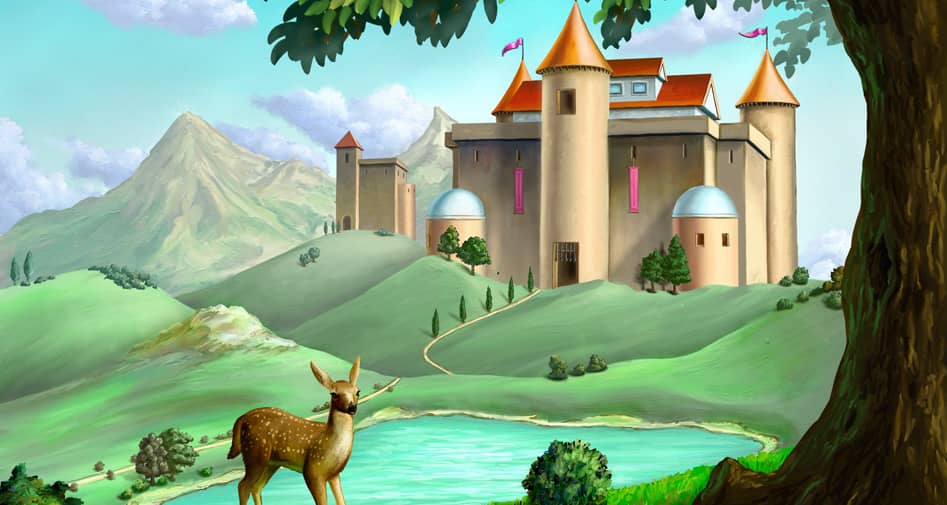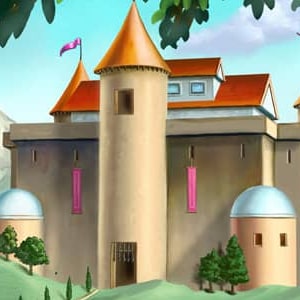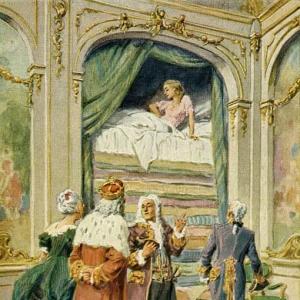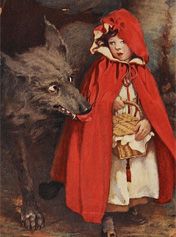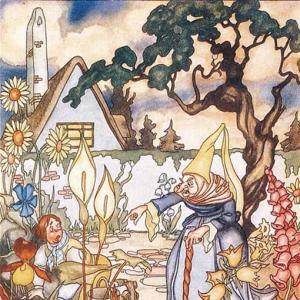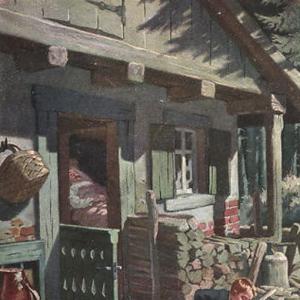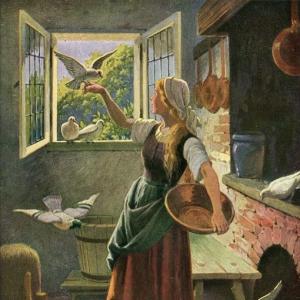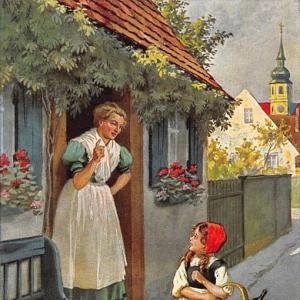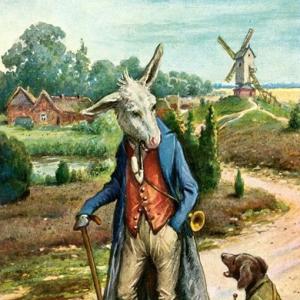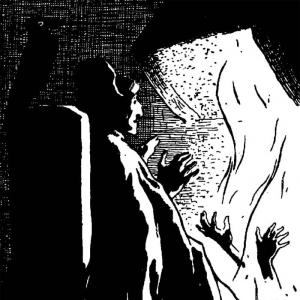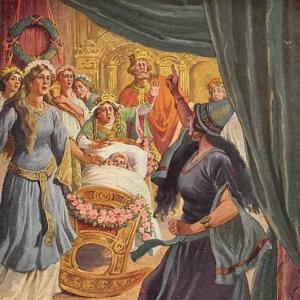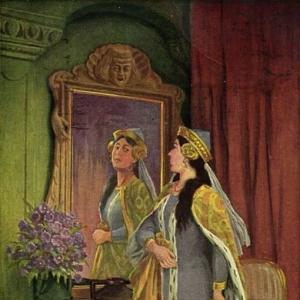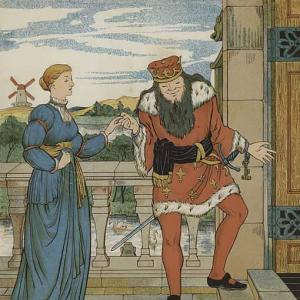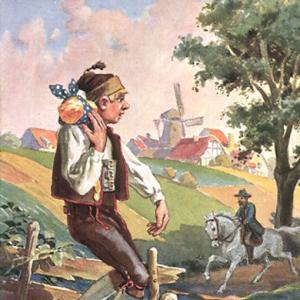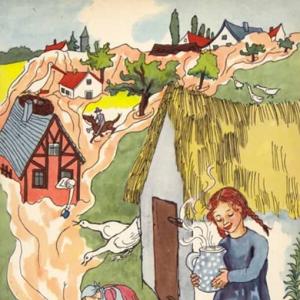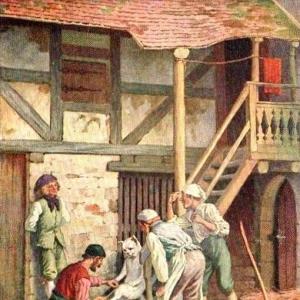Reading time for children: 5 min
Of course you know what is meant by a magnifying glass– one of those round spectacle-glasses that make everything look a hundred times bigger than it is? When any one takes one of these and holds it to his eye, and looks at a drop of water from the pond yonder, he sees above a thousand wonderful creatures that are otherwise never discerned in the water. But there they are, and it is no delusion. It almost looks like a great plateful of spiders jumping about in a crowd. And how fierce they are! They tear off each other’s legs, and arms and bodies, before and behind; and yet they are merry and joyful in their way.
Now, there once was an old man whom all the people called Kribble-Krabble, for that was his name. He always wanted the best of everything, and when he could not manage it otherwise, he did it by magic.
There he sat one day, and held his magnifying-glass to his eye, and looked at a drop of water that had been taken out of a puddle by the ditch. But what a kribbling and krabbling was there! All the thousands of little creatures hopped and sprang and tugged at one another, and ate each other up.
„That is horrible!“ said old Kribble-Krabble. „Can one not persuade them to live in peace and quietness, so that each one may mind his own business?“ And he thought it over and over, but it would not do, and so he had recourse to magic. „I must give them color, that they may be seen more plainly,“ said he; and he poured something like a little drop of red wine into the drop of water, but it was witches‘ blood from the lobes of the ear, the finest kind, at ninepence a drop. And now the wonderful little creatures were pink all over. It looked like a whole town of naked wild men.
„What have you there?“ asked another old magician, who had no name– and that was the best thing about him.
„Yes, if you can guess what it is,“ said Kribble-Krabble, „I’ll make you a present of it.“ But it is not so easy to find out if one does not know.
And the magician who had no name looked through the magnifying-glass. It looked really like a great town reflected there, in which all the people were running about without clothes. It was terrible! But it was still more terrible to see how one beat and pushed the other, and bit and hacked, and tugged and mauled him. Those at the top were being pulled down, and those at the bottom were struggling upwards. „Look! look! his leg is longer than mine! Bah! Away with it! There is one who has a little bruise. It hurts him, but it shall hurt him still more.“ And they hacked away at him, and they pulled at him, and ate him up, because of the little bruise. And there was one sitting as still as any little maiden, and wishing only for peace and quietness. But now she had to come out, and they tugged at her, and pulled her about, and ate her up.
„That’s funny!“ said the magician.
„Yes; but what do you think it is?“ said Kribble-Krabble. „Can you find that out?“
„Why, one can see that easily enough,“ said the other. „That’s Paris, or some other great city, for they’re all alike. It’s a great city!“
„It’s a drop of puddle water!“ said Kribble-Krabble.
 Learn languages. Double-tap on a word.Learn languages in context with Childstories.org and Deepl.com.
Learn languages. Double-tap on a word.Learn languages in context with Childstories.org and Deepl.com.Backgrounds
Interpretations
Adaptions
Summary
Linguistics
„The Drop of Water“ is a lesser-known fairy tale by Hans Christian Andersen, a Danish author who lived from 1805 to 1875. Andersen is best known for his classic fairy tales, such as „The Little Mermaid,“ „The Ugly Duckling,“ „The Emperor’s New Clothes,“ and „The Snow Queen.“ His stories often contain moral lessons and commentaries on human nature, society, and the complexities of life.
Hans Christian Andersen’s fairy tales have been translated into more than 150 languages and have become an integral part of world literature. Andersen’s works were initially published between 1835 and 1872, with „The Drop of Water“ appearing in the 19th-century collection of his fairy tales.
Andersen drew inspiration from various sources, including folklore, mythology, and his own life experiences. His stories often feature elements of magic and fantasy, as well as the exploration of human emotions and relationships. Despite being primarily targeted at children, Andersen’s tales have a timeless appeal that continues to resonate with readers of all ages.
In „The Drop of Water,“ Andersen uses the motif of the magnifying glass and the microscopic world it reveals to convey a deeper message about human nature, society, and the consequences of meddling with forces beyond our understanding. The story offers a glimpse into the author’s fascination with the natural world and his keen observations of human behavior.
„The Drop of Water“ by Hans Christian Andersen can be interpreted in various ways, with some key themes emerging:
Human nature and society: The story highlights the chaotic and violent nature of both the microscopic creatures and the human beings living in a great city. This parallel suggests that competition, aggression, and the struggle for power are inherent aspects of life, regardless of scale or complexity. It serves as a commentary on the darker aspects of human nature and the way people behave in a society where everyone is vying for a better position.
Illusion and reality: The tale showcases the power of the magnifying glass to reveal a hidden world within a seemingly ordinary drop of water. This idea can be extended to the human experience, where our perceptions are often limited by our senses and what we see may not always be the complete reality. The story encourages readers to look beyond the surface and seek a deeper understanding of the world around them.
The dangers of meddling: Kribble-Krabble’s decision to use magic to make the water creatures more visible can be interpreted as a warning against meddling with natural processes. By interfering, he inadvertently intensifies the violence among the creatures. This theme cautions against the potential consequences of tampering with nature or trying to control things beyond our understanding.
Power and corruption: The story shows how those who have power (in this case, the magicians) can be tempted to use it for their own purposes, often with unintended consequences. Kribble-Krabble’s use of magic to manipulate the creatures in the water drop is an example of how power can be misused, highlighting the need for responsibility and restraint.
Overall, „The Drop of Water“ can be interpreted as a cautionary tale about human nature, the complexities of society, and the potential dangers of wielding power. It challenges readers to examine their own perceptions, behaviors, and values and to be mindful of the consequences of their actions.
„The Drop of Water“ by Hans Christian Andersen has inspired several adaptations in various media. Here are a few examples.
Animated Short Film: In 1981, a 20-minute animated short film adaptation of „The Drop of Water“ was released in Denmark. The film was directed by Jannik Hastrup and featured music by Flemming Quist Møller. It follows the story of the drop of water as it travels through different environments and encounters various creatures.
Children’s Book: In 2011, a children’s book adaptation of „The Drop of Water“ was published by Barefoot Books. The book was illustrated by artist Lena Anderson and adapted by John A. Rowe. It follows the same story as Andersen’s original, with vibrant illustrations bringing the various creatures and environments to life.
Puppet Show: In 2013, a puppet show adaptation of „The Drop of Water“ was performed at the Puppet Theater in Copenhagen. The show featured life-size puppets of the various creatures that the drop of water encounters on its journey.
Art Installation: In 2021, an art installation inspired by „The Drop of Water“ was created by the Danish artist Jeppe Hein. The installation, titled „Water Pavilion,“ features a circular pool of water surrounded by a wooden deck. Visitors can walk around the edge of the pool, interacting with the water and observing its movement.
Overall, „The Drop of Water“ has inspired adaptations that range from traditional storytelling to more experimental forms of art. Each adaptation brings its own interpretation to Andersen’s original story, highlighting different aspects of its themes and characters.
„The Drop of Water“ is a fairy tale by Hans Christian Andersen that explores the world of microscopic creatures and human nature through the perspective of two old magicians. The story begins with an explanation of a magnifying glass and its ability to reveal thousands of tiny creatures that inhabit a drop of water. These creatures are fierce, tearing each other apart, yet they are also merry and joyful.
The protagonist, an old man named Kribble-Krabble, is known for always wanting the best of everything and resorting to magic when necessary. One day, he uses his magnifying glass to examine a drop of water taken from a puddle by a ditch. He is disturbed by the violent interactions among the creatures and wonders if they can be persuaded to live in peace. Unable to find a solution, he decides to use magic and adds witches‘ blood to the water to make the creatures more visible. The result is a vivid scene resembling a town of naked wild men.
Another old magician, who has no name, becomes curious about Kribble-Krabble’s discovery. Kribble-Krabble challenges him to guess what it is, promising to give it to him if he can. The nameless magician peers through the magnifying glass and sees a chaotic scene, with people attacking each other in a brutal, merciless manner. He believes it must be a representation of a great city, such as Paris, as all big cities are alike in their cruelty and disorder. Kribble-Krabble then reveals that the scene is, in fact, just a drop of puddle water.
The story draws a parallel between the microcosm of the water creatures and the macrocosm of human society, suggesting that, despite our differences in scale, we share an innate propensity for violence, competition, and chaos.
Hans Christian Andersen’s „The Drop of Water“ presents itself as a whimsical yet thought-provoking fairy tale that utilizes linguistic elements to convey deeper allegorical meanings.
Descriptive Language and Imagery: Andersen employs vivid descriptions and strong imagery to illustrate the microscopic world within the drop of water. Phrases like „great plateful of spiders“ and „whole town of naked wild men“ create a vivid picture of chaos and savagery. The detailed depictions of creatures tearing and eating each other emphasize the brutality and disorder present in this miniature universe.
Metaphor and Allegory: The tale is an allegory, using the microcosm within the drop of water as a metaphor for human society. By portraying the microscopic creatures as a chaotic and violent society, Andersen comments on the savage aspects of human nature and civilization. The creatures‘ behavior represents societal conflicts, class struggles, and the perpetual human dissatisfaction, highlighted by lines such as „those at the top were being pulled down, and those at the bottom were struggling upwards. “
Character Names and Dialogue: The character „Kribble-Krabble“ is named in a way that phonetically resembles the scuttling or chattering sounds, providing a whimsical tone, yet reinforcing the disorderly theme. The dialogue between Kribble-Krabble and the nameless magician introduces varying perspectives. The nameless magician’s ability to easily identify the chaos as reflective of a grand city introduces the commentary on societal issues, as he nonchalantly equates the micro-world’s pandemonium to that of Paris or any large city.
Contrast and Irony: Andersen uses irony, especially through the naivety of Kribble-Krabble’s attempts to impose order onto the chaos he observes. His solution to use „witches‘ blood“ signifies a misguided attempt at control, highlighting the futility of imposing external solutions on deeply rooted societal issues. The realization that the drop of water mimics a city reflects the larger irony; that despite technological or magical advancements (symbolized by the magnifying glass and the witch’s blood), human society remains intrinsically conflicted and violent.
Symbolism: The magnifying glass represents insight and perception, allowing the hidden realities of society to be revealed. The contrast of the tiny, savage creatures against the backdrop of the grand city they symbolize underscores the pettiness of human conflicts when viewed from an objective standpoint.
Conclusion
Through „The Drop of Water,“ Andersen adeptly uses linguistic devices to frame a narrative that is both captivating and insightful. The tale juxtaposes the minuscule with the grand, the trivial with the profound, offering readers a mirror to their societal behaviors and structures. The story encourages reflection on the inherent chaos of society and the often invisible yet omnipresent nature of human conflict and folly.
Information for scientific analysis
Fairy tale statistics | Value |
|---|---|
| Translations | DE, EN, DA, ES, IT |
| Readability Index by Björnsson | 23.3 |
| Flesch-Reading-Ease Index | 87.1 |
| Flesch–Kincaid Grade-Level | 4.3 |
| Gunning Fog Index | 6.9 |
| Coleman–Liau Index | 7.7 |
| SMOG Index | 7.6 |
| Automated Readability Index | 3.7 |
| Character Count | 3.145 |
| Letter Count | 2.388 |
| Sentence Count | 47 |
| Word Count | 598 |
| Average Words per Sentence | 12,72 |
| Words with more than 6 letters | 63 |
| Percentage of long words | 10.5% |
| Number of Syllables | 755 |
| Average Syllables per Word | 1,26 |
| Words with three Syllables | 27 |
| Percentage Words with three Syllables | 4.5% |
